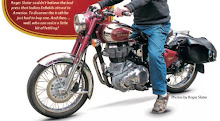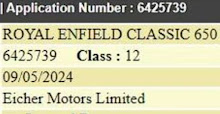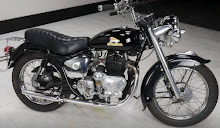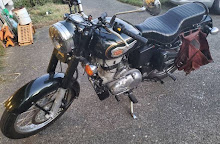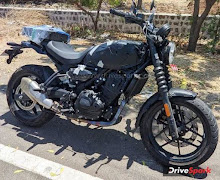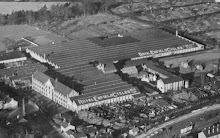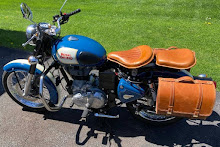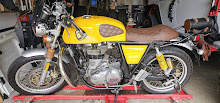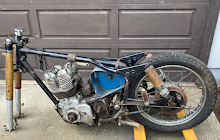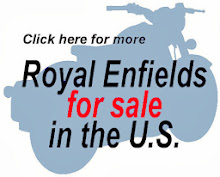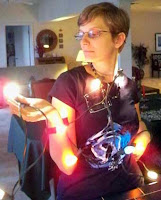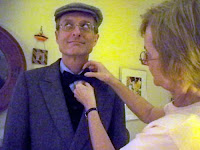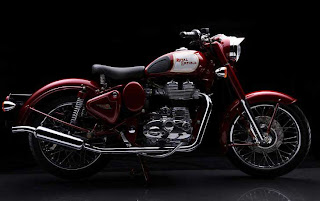 |
| Foglio brothers still possess banner from '60s dealership. |
Tony was gracious enough to tell me the story and provide the pictures you see here. He wrote:
"My brother Jim was racing a BSA 650 Hornet, the one with the fiberglass tank, and my oldest brother had bought a 1965 Royal Enfield that he bought from a small dealer named Cliff Jenkins. He made a chopper out of it, as you did in those days.
"The original reason we chose to become Royal Enfield dealers was that you only had to buy a couple of bikes. Anything else, and you would have had to have had a pile of money."
 |
| Royal Enfield Interceptors. |
"We had $1,000 apiece to put into it. We went to Bristol, Pa., to meet with the distributor, Gene Shillingford and Sons, and bought two Interceptors and two Sachs motorcycles, German dirt bikes. We (continued) to sell them until we couldn't get them anymore, and we were the largest RE dealer in the states.
"And we raced them; drag raced them. The Interceptor would get into the lower 13 seconds, stock. My brother was really good and I think he got into the high 12s. That's one way we sold them. We'd talk to the guys on Harleys and we'd say, 'OK, if we beat you, come buy one.' Sold a lot of bikes that way.
 |
| Tony Foglio's 1969 Interceptor. |
 |
| Oil cooler on Royal Enfield Interceptor. |
"Why? Because the limit to race at the Isle of Mann is 800cc. I asked how many Royal Enfields they would race at the Isle of Mann and he said 'one.' I couldn't believe that they would keep all those motorcycles under 800cc (to suit) one race."
 |
| Interceptor's 150-mph speedometer. |
"Well, we didn't ask, and he didn't tell. But I can't imagine him coming all the way to Canada and the U.S. to see all the distributors if they knew it was going to end; although he might have picked up some information about what was coming.
"When the end came it was really alright with us business wise, because in 1970 we picked up a Suzuki franchise. And we did real well. We went from probably a 1,000 square foot building to a 20,000 square foot building."
It wasn't clear, at first, that Japanese motorcycles were to become the wave of the future.
"I didn't like them at all. They were two-stroke, they smoked and they made that ring-a-ding noise. The Interceptors were great handling and they had all that bottom end, and then you go to two strokes and it's all top end.
"The Suzuki 500s had pressed steel tanks and quality was mediocre. But the thing was, the number of cc's they were, that is about what they cost us: $500. We might have been paying $1,000 or $1,200 for an Interceptor, I don't remember. I think we sold them for around $1,500.
"That was a lot of money. You could buy a fully loaded new Volkswagen for $2,000.
"The Japanese were great marketers, and it didn't take them long. They took mediocre stuff and in a few years were making stuff you couldn't compete with.
 |
| The prettiest bike ever made. |
"The Interceptors had the lousiest brakes in the world; you needed some room to get stopped. Riders who'd been on Japanese motorcycles would come test them and you'd see them go down the road and stop; they'd hit the brake instead of the gearshift, which was on the right instead of the left.
"The only real problem we ever had with them was a nylon tab in the primary chain tensioner. If you ran them hard you'd go through those pretty fast and there'd be the sound of metal on metal."
What about the made-in-India Enfields?
"In 2001 I was in India and I went to the factory; I didn't know you could tour it, but there was a showroom and they had both the 350 and the 500 and a 350 diesel that astounded me. Did you want to take a ride? And I said sure and I went for a ride — of course I was on the wrong side of the road.
"But I was very impressed. I didn't think it would, but the 500 had the same sound and feel as the Interceptor. I wasn't real pleased with the metallurgy of the engine or the fenders. I had the thought of opening a dealership in California but, at the time, there was one state where you couldn't sell them and that was California. But I understand they're now making a heck of a bike, with a new engine."
In the mid-1970s the Foglios sold the motorcycle dealership and Tony moved to California in 1980. He found Christ through a Billy Graham Crusade and eventually became a pastor, founding the Sonrise Church. His son took over as pastor when he retired.
The three Foglio brothers got back into Royal Enfields, finding between them a 1970 and two 1969s. These were immaculate motorcycles, with early production numbers. "We found bikes that had been from our dealership, but they were beat to death," Tony said.
 |
| The Foglio brothers back on two wheels. |
"I didn't sell it so much as put it out for adoption," he said.
 |
| Joe, Jimmy and Tony Foglio. |

